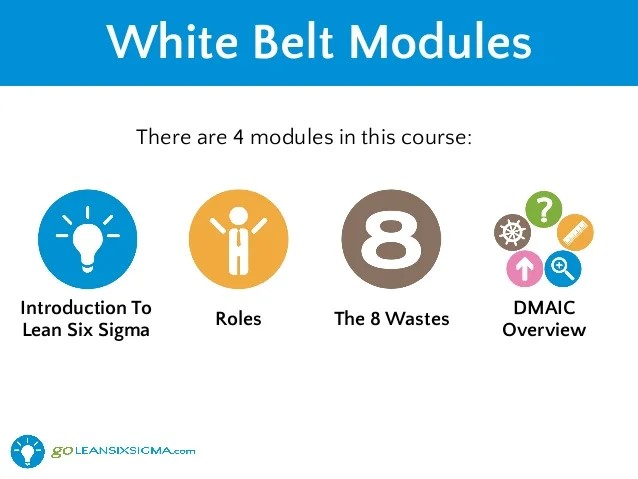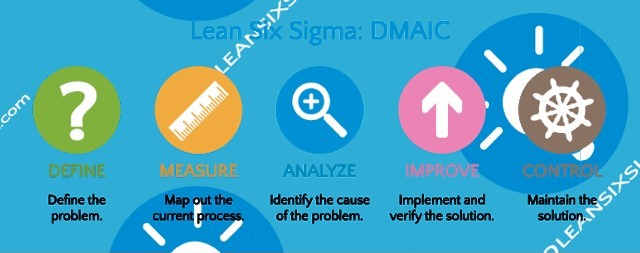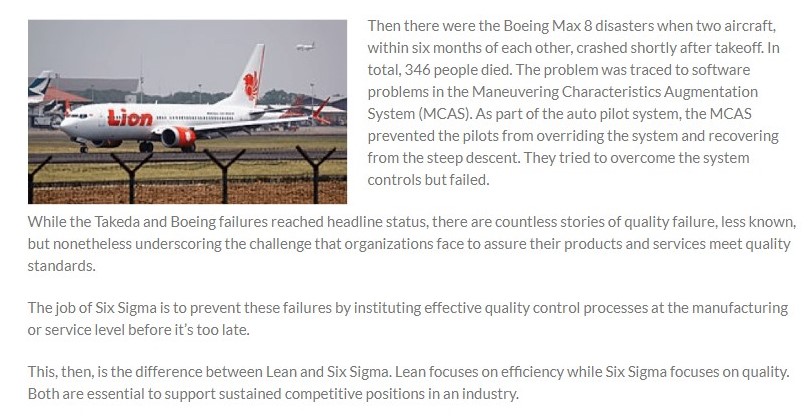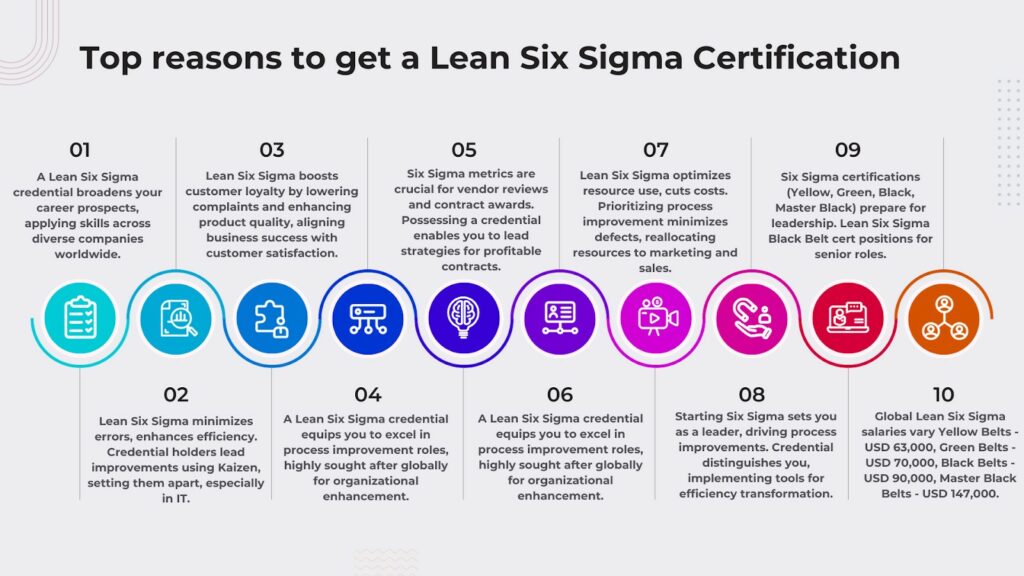Industries, especially manufacturing industries, are highly competitive, and certified Lean Six Sigma professionals are one of their most precious assets. Manufacturing industries often incur tons of loss in terms of time management, resource utilization, operational structure, etc. Lean Six Sigma methodology is a process that ensures the improvement of operational performance by systematically removing waste and reducing process variation with the help of a collaborative team. There are various levels of Lean Six Sigma Certification, each with its contribution to the industry. This blog will provide a thorough overview of Lean Six Sigma Certification levels as preferred by industries globally.
What are Lean Six Sigma Certifications?
Lean Six Sigma is necessary because it helps to achieve high quality and customer satisfaction in the manufacturing industry. It also helps to reduce costs, increase efficiency, and enhance competitiveness. This methodology also focuses on eliminating defects, errors, and variations in the production process, as well as optimizing the use of resources and time.
These Lean Six Sigma certifications signal individuals’ qualifications for project roles and advancing quality management practices. A Lean Six Sigma Certificate Program empowers professionals to contribute to optimizing company culture and preventing downtime actively. There are five major Lean Six Sigma certification programs that professionals often pursue to upskill themselves and excel in their careers.

Image source: dcmlearning
The Lean methodology, a manufacturing principle with a focus on waste reduction, is often associated with the acronym “DOWNTIME,” representing eight types of waste. These include Defects (D), Overproduction (O), Waiting (W), Non-used talent (N), Transportation (T), Inventory (I), Motion (M), and Extra-processing (E). The Lean Six Sigma method, aligned with the goal of waste reduction and quality improvement, shares many foundational ideas with the Lean approach.

Image source: startupindiamagazine
Lean Six Sigma White Belt Certification
A Certified Six Sigma White Belt from the Council for Six Sigma Certification (CSSC) possesses and demonstrates a fundamental understanding of the basic level of the Six Sigma Methodology. This certification signifies the individual’s knowledge of the fundamental definition, history, and structure of Six Sigma, offering a robust awareness of those involved in its implementation and their roles within an organization. However, there are two different paths to this certification that individuals or professionals can go through.

Image source: xtxtshop
Path 1: Suitable for candidates who
- Have undergone prior training and possess a substantial grasp of the “Body of Knowledge.
- Seek a single level of certification.
- Are comfortable completing their exam within 30 minutes.
Path 2: Ideal for candidates who
- Utilize our free Self-Study Guides independently or in tandem with a training provider.
- Aim to earn different levels of “Belts” progressively without incurring additional examination fees.
- Anticipate the need for more than three attempts to pass the examination.
- Prefer a non-timed exam format.
Lean Six Sigma Yellow Belt Certification
In yellow belt training, the focus is frequently on grasping the overall methodology and basic data collection. Yellow belts are not required to execute hypothesis testing, but they must comprehend the language of hypothesis testing and the resulting conclusions. Typically, yellow belts are employees seeking insight into the overall process and its implementation rationale.
Lean Six Sigma Yellow Belt is a certification level that demonstrates a basic knowledge of Lean Six Sigma methodology and its application to improve processes. A Lean Six Sigma Yellow Belt can participate as a project team member, support Green Belt or Black Belt projects, and run smaller process improvement projects using the PDCA (Plan, Do, Check, Act) cycle.

Image source: goodhrissk
Some of the topics that are taught in Lean Six Sigma Yellow Belt training are:
The following concepts are often included in Six Sigma Yellow Belt training:
- Six Sigma roles
- Team development and management
- Basic quality tools such as Pareto charts, run charts, scatter diagrams, and histograms
- Common Six Sigma metrics
- Data collection
- Measurement system analysis
- Root cause analysis
- An introduction to hypothesis testing

Lean Six Sigma Green Belt Certification
Certified Green Belts play a crucial role within Six Sigma teams, typically working under the guidance of a Black Belt or Master Black Belt. With intermediate statistical analysis skills, they address data and analysis concerns, assist Black Belts in applying Six Sigma tools, and educate others in the organization about the methodology. Green Belts, including middle managers, business analysts, and project managers, are actively involved in process improvement initiatives. Often regarded as the “worker bees” of Six Sigma, they handle statistical data collection and analysis efficiently under the supervision of certified Black Belts.

Image source: ziprecruiter
What is there in the Lean Six Sigma Green Belt Training Program?
The following concepts are often included in Green Belt training:
- All of the information listed for Yellow Belt certification
- Failure mode and effects analysis
- Project and team management
- Probability and the Central Limit Theorem
- Statistical distributions
- Descriptive statistics
- How to perform basic hypothesis testing
- Waste Elimination and Kaizen
- Basic control charts
Lean Six Sigma Black Belt Certification
A Lean Six Sigma Black Belt certification focuses on equipping professionals with advanced skills and expertise in process improvement and optimization. Participants delve deep into Lean and Six Sigma methodologies, gaining proficiency in leading complex improvement projects. Typically serving as the leader for process improvement projects, a certified Six Sigma Black Belt may also hold positions in management, analysis, or planning across various departments within a company.
The Black Belt level emphasizes a thorough understanding of statistical tools, analytical techniques, and project management strategies. Individuals learn to identify areas for improvement, implement solutions, and sustain positive changes within an organization.

Image source: zippia
What are the Topics that the Lean Six Sigma Black Belt covers?
- Advanced project and team management skills
- Knowledge of the expansive list of Six Sigma brainstorming and project tools
- Intermediate to advanced statistics
- An understanding of other process improvement and quality programs, including Lean and Total Quality Management
- An ability to design processes
- Advanced capabilities for diagramming processes, including flow charts and value stream maps
- Use of software to conduct analysis, such as Excel or Minitab
Lean Six Sigma Master Black Belt Certification
The Master Black Belt program in Lean Six Sigma equips individuals for leadership, enabling them to act as strategists in organizational transformation. This initiative goes beyond statistical expertise, transforming Black Belts into Change Management Champions who can teach, mentor, and guide organizations in strategically utilizing Lean Six Sigma for organizational excellence.

Image source: ziprecruiter
Main Phases of Lean Six Sigma Master Black Belt Certification
Phase 1: Centers on honing leadership abilities, cultivating strategic thinking, managing conflicts, instilling principles of business excellence, navigating change, addressing resistance, establishing improvement and innovation frameworks, deriving business value from organizational excellence, and employing advanced statistical approaches including non-parametric analysis, QFD, DFMEA, IDOV, DMADV, TOC, and more. Real-life challenges faced by participants are openly discussed in sessions, offering practical guidance on overcoming these challenges.
Phase 2: Centers on discussing the pragmatic application of statistical tools. Additional sessions delve into innovation and creativity tools like Design Thinking, Jugaad, Six Thinking Hats, SCAMPER, and others. Covers concepts of process automation, data visualization, and BI Tools with practical applications demonstrated across diverse business scenarios. Encourages participants to engage in brainstorming using virtual/live scenarios, supplemented by diverse case studies incorporated into classroom exercises.
In a nutshell,

Image source: it.ucsb.edu
How does Lean Six Sigma work?
This comes to a point where we’ll discuss what are the major differences between Six Sigma and Lean Six Sigma.

Image source: 6sigmacertificationonline
Lean Six Sigma is the combination of two interrelated processes called the Lean principles and the Six Sigma principles. Lean focuses on three major goals:
- Delays
- Errors
- Waste

Image source: 6sigmacertificationonline
Whereas, Six Sigma emphasizes:
- Quality
- Consistency

Image source: 6sigmacertificationonline
Lean Six Sigma functions as a hybrid methodology, amalgamating the strengths of Six Sigma in ensuring quality and consistency, and the efficiency focus of Lean. Its primary objective is to assist organizations in providing customer value through streamlined operations and adherence to quality standards, ultimately leading to the production of superior products and services. Its widespread popularity across various industries stems from its comprehensive approach that addresses both quality and efficiency concerns. Whether in healthcare or government agencies, Lean Six Sigma finds applicability across diverse sectors and job functions.
The following are the benefits of the Lean Six Sigma Methodology:
- Boost Profits
- Trim Costs
- Elevate Efficiency & Quality
- Heighten Customer Satisfaction
- Foster Employee Development
Lean Six Sigma or Six Sigma Certification?
We always pursue certification to ensure career upliftment. Therefore, Lean Six Sigma and Six Sigma certifications should be considered concerning the industries that hire professionals with these certifications.
If you want to go for the industries mentioned below, you should go for a Lean Six Sigma certification.

Image source: goleansixsigma
1. Government Sector: Governments worldwide favor Lean Six Sigma as their preferred variant of Six Sigma due to its effectiveness in addressing the immense scale of tasks faced by governmental bodies. By implementing Lean Six Sigma, governments can identify areas for cost reduction, eliminate unnecessary positions, and enhance the overall quality of services. The adoption of Lean Six Sigma by governments underscores its applicability and success within the public sector, challenging common assumptions.
2. Manufacturing Sector: In the manufacturing industry, Lean Six Sigma has gained immense popularity for its transformative impact. Applying Lean Six Sigma methodologies yields improvements in product quality and factory output. Companies leveraging Lean Six Sigma can streamline their manufacturing operations, resulting in reduced waste and costs, coupled with an enhancement in product quality. Esteemed global organizations like Dell, Xerox, and General Electric have witnessed significant financial savings through the successful implementation of Lean Six Sigma.

3. Finance Sector: The finance sector has increasingly embraced Lean Six Sigma methodologies to expedite its processes. Consider the scenario in banks, where a multitude of loan applications is received weekly, navigating through various departments before reaching the loans department. The Lean Six Sigma approach aims to streamline and simplify this intricate process by eliminating unnecessary steps, thereby accelerating and enhancing the efficiency of loan processing in financial establishments.
Similarly, a Six Sigma certification will be the best option if you want to go for the following industries:
4. Healthcare: In healthcare, Six Sigma roles ensure top-notch patient care and operational efficiency. Positions like Healthcare Quality Improvement and Data Analysts, Process Improvement Managers, and Revenue Cycle Program Managers contribute to precision and patient-centric operations, enhancing overall healthcare delivery.
5. Telecommunication: Telecommunications benefit from Six Sigma’s systematic approach. Roles like Process Analysts and Six Sigma Managers streamline processes, minimizing inefficiencies, and ensuring superior services. Six Sigma in telecom is vital for operational efficiency and customer satisfaction.
6. Information Technology (IT): Information Technology relies on Six Sigma for streamlined processes and high-quality outcomes. Roles such as Project Managers specializing in Six Sigma and Lean processes, and Senior Consultants in Lean Six Sigma and Project Management, apply Six Sigma to projects, automated processes, and customer support, ensuring efficiency across various IT functions.
7. Manufacturing: Manufacturing thrives on Six Sigma for continuous improvement and quality assurance. Roles like Process Analysts, Six Sigma Managers, and Lean Manufacturing Engineers reduce waste and errors, optimizing production processes for higher-quality products and operational excellence.
8. Apparel and Textiles: Apparel and textiles benefit from Six Sigma’s precision. Roles like Directors of Process Engineering and Process Analysts focus on enhancing manufacturing efficiency. Six Sigma lowers costs, reduces waste, and improves production and garment quality, utilizing methods like Statistical Process Control and Engineering Process Control for consistent quality.
Lean Six Sigma Certification Salary
Lean Six Sigma certified professionals are paid quite hefty and that is one of the crucial reasons why they go for this certification. Indeed shares an overall salary structure of these professionals.

Let’s now see some of the prominent organizations that hired skilled and certified Lean Six Sigma professionals.

Image source: indeed
Top Reasons to Get a Lean Six Sigma Certification

1. Versatile Application Across Industries
Six Sigma isn’t confined to manufacturing; it spans industries like telecom, IT, aerospace, healthcare, shipping, banking, financial services, HR, and marketing. A Lean Six Sigma credential broadens your career prospects globally, making your skills applicable across diverse companies worldwide.
2. Error Reduction and Process Enhancement
Lean Six Sigma aims to reduce errors and defects, fostering efficiency. With this credential, you can lead improvements by applying Kaizen and mistake-proofing, ensuring quick turnarounds. In IT, this knowledge minimizes errors, complaints, spending, and schedule slippages, setting you apart from your peers.
3. Enhanced Customer Satisfaction
Beyond defect reduction and efficiency, Lean Six Sigma lowers customer complaint rates, influencing customer loyalty. Improving product quality reduces customer unhappiness, aligning business success with customer satisfaction.
4. Business Process Improvement
Achieving a Lean Six Sigma credential equips you to understand, measure, analyze, control, and improve organizational processes. Skilled professionals in process improvement are highly sought after globally, and Lean Six Sigma opens doors to such roles.
5. Adherence to Standards
Six Sigma metrics are integral for vendor reviews and awarding contracts. Possessing a Six Sigma credential enables you to lead strategies, securing profitable contracts in both private and public sectors, and ensuring your organization meets industry and government standards.
6. Optimized Resource Utilization
Lean Six Sigma showcases your ability to efficiently utilize resources, reducing operational costs. By focusing on process improvement over course correction, this methodology minimizes defects, and errors, and directs more resources toward marketing and sales.
7. Stand Out and Drive Change
Initiating your Six Sigma journey positions you as a frontrunner, driving process improvement initiatives. A Six Sigma credential distinguishes you from your uncertified counterparts, allowing you to implement tools and training for performance and efficiency transformation.
8. Leadership Opportunities
Various Six Sigma certification levels, including Yellow Belt, Green Belt, Black Belt, and Master Black Belt, prepare professionals for leadership roles. A Lean Six Sigma Black Belt certification, in particular, positions you for senior management and leadership roles.
9. Attractive Salary Remuneration
Six Sigma professionals command high salaries globally. According to PayScale, average annual salaries vary based on expertise: USD 63,000 for Yellow Belts, USD 70,000 for Green Belts, USD 90,000 for Black Belts, and USD 147,000 for Master Black Belts.
10. Competitive Differentiation
A Six Sigma-certified workforce sets your organization apart from competitors. Decision-makers recognize Six Sigma as a valuable methodology, akin to its success at Motorola, GE, Ford, and Toyota. Implementing Six Sigma can save money, and time, and elevate service quality, providing a distinct edge in the market.
Conclusion
In conclusion, obtaining a Lean Six Sigma Certification proves invaluable for professionals seeking versatility across industries, leadership roles, and substantial salary benefits. This credential not only equips individuals with the tools for process improvement but also sets them apart in the competitive landscape, making a significant impact on organizational efficiency and success.
